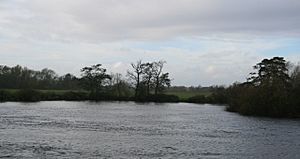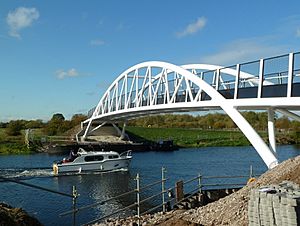Derwent Mouth facts for kids
Derwent Mouth is a special place where three important waterways meet. It's located on the River Trent, which acts as a border between the English counties of Derbyshire and Leicestershire. This spot is where the River Derwent flows into the River Trent. It's also where the Trent and Mersey Canal connects to the River Trent.
Derwent Mouth is about 1.6 kilometers (1 mile) east of Shardlow. It is also about 3.2 kilometers (2 miles) west of Trent Lock. At Trent Lock, the River Soar and Erewash Canal also join the River Trent. This area is about 14.5 kilometers (9 miles) southwest of Nottingham and 11.3 kilometers (7 miles) southeast of Derby.
The River Trent is a busy waterway. Boats can travel downstream from Derwent Mouth all the way to the Humber Estuary. They use special water lifts called locks to change river levels. The Trent is also navigable for a short distance upstream. However, most boats heading further upstream use the Trent and Mersey Canal. This canal connects to the River Mersey and other canals in the West Midlands. The River Derwent, however, is not used by boats.
Contents
Long Horse Bridge: A River Crossing
Long Horse Bridge is a very important bridge near Derwent Mouth. It helps people cross the River Trent. The first bridge here was made of wood. It was built so that horses pulling barges could cross the river. This allowed them to continue along the towpath on the other side of the Trent.
The Old Wooden Bridge
In 1893, a big flood caused problems for the wooden bridge. Large blocks of ice came crashing down the river. They hit the bridge's support legs, causing it to collapse. Some boat workers tried to save the bridge. They added heavy loads to it and pushed away the ice. When the bridge finally broke, one man, James Thompson, ended up floating on the ice. Luckily, he reached the riverbank safely. After this event, the wooden bridge was rebuilt.
The Concrete Bridge
In 1932, the Trent Navigation company replaced the wooden bridge. They built a new one in the same spot using strong reinforced concrete. After 70 years, this concrete bridge started to wear out. It was closed in 2002 because it was no longer safe. The bridge was taken down a year later.
The New Bridge Today
Instead of rebuilding the same kind of bridge, a new plan was made. A wider bridge was built about 140 meters (460 feet) upstream from Derwent Mouth. This new bridge is for walkers, cyclists, and horse riders. The main part of the bridge, weighing 60 tonnes, was lifted into place in September 2011. It opened in November of the same year. This project cost £1.4 million. The bridge is 52 meters (170 feet) long.
The new bridge solved several problems for outdoor enthusiasts. It allows the Midshires Way bridleway to cross the Trent. It also reconnected the towpath between Shardlow and Sawley. Before, people had to take a long detour. The bridge also links the Trent Valley footpath with the Derwent Valley Heritage Way. This trail ends right at Derwent Mouth.



